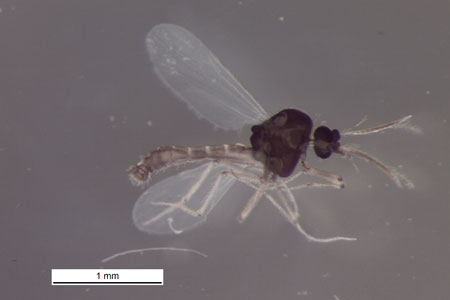Postdoc Carsten Kirkeby simply had to investigate an annoyingswarm of midges while holidaying in Sweden. It proved to be a disease-carrying species from Siberia.
By Mette Buck Jensen
Despite holidaying in Sweden this past June, postdoc Carsten Kirkeby from the Section of Epidemiology at DTU Vet could not ignore his interest in the small mosquitoes called midges.
While out on a walk, I suddenly found myself under a large swarm of midges, and, naturally, I collected a couple to identify the species,” recounts Carsten Kirkeby, who continues:
"However, on returning to the department lab, I was unable to immediately identify the species. Fortunately, DTU Vet has access to an extensive network of researchers throughout Europe, so I sent one of the midges to a female colleague in Poland. Based on the colouring and the males’ unusually large genitalia, she was able to identify the specimen—Culicoides Gornostaeva—a species previously known only to inhabit eastern Siberia.”
His colleague in Poland—Dr Patrycja Dominiak, University of Gdansk—then set about checking her collection of midges and discovered the presence of the species in earlier collections from Norway and Poland.

Exciting discovery
“It is amazing to discover a midge from Siberia in Europe, and particularly interesting and important knowledge given the likelihood of its ability to spread diseases here. Among other things, it is very closely related to the midge species Culicoides obsoletus, which is responsible for spreading serious diseases to our ruminants,” explains Carsten Kirkeby.
For example, in the past year, Denmark and Europe have seen outbreaks of the bluetongue virus and the Schmallenberg virus, which are transferred between cattle, sheep and goats by Culicoides obsoletus. The consequences were serious—including reduced milk production, miscarriages and deformed offspring.
“It is still a mystery to me why no one has discovered the Siberian midge here before now. Perhaps it is gone undetected by European midge researchers because it lives in deep woodland—or perhaps it has simply been overlooked among the many midges that have been caught in recent years,” says Carsten Kirkeby.
The discovery of the Siberian midge in Sweden, Norway and Poland was recently published in the scientific journal Parasites & Vectors. The collected midges have now been sent for further study in Sweden and France, where their DNA will be mapped.
Article in DTUavisen no. 8, October 2014.